Rakhiv to Mariupol: Riding Ukraine’s Longest Train Route
This review details a ride on the night train from Rakhiv to Mariupol, Ukraine’s longest passenger railway route before the Russian invasion.
Rakhiv to Mariupol train
On 12th December 2021 – just months before the Russian invasion – the Ukrainian Railways (Ukrzaliznytsia) started their longest ever passenger railway route by launching direct trains between Rakhiv and Mariupol.
The Rakhiv to Mariupol train traverses 12 different ‘oblasts’ (regions) on its long journey across Ukraine and takes just under 29 hours to complete the 1806-kilometre-long route.
To put this into perspective: That’s the same distance as Amsterdam to Lisbon or Warsaw to Athens!
Not only does the train connect several large Ukrainian cities such as Mariupol, Zaporizhzhia, Dnipro, Lviv and Ivano-Frankivsk, but it also stops at a couple of popular tourist destinations in the Carpathian Mountains such as Tatariv (the station closest to the ski resort of Bukovel).
Needless to say, I was absolutely looking forward to travel on this train.
Taking a train ride across a country as vast as Ukraine really makes you understand its diverse geography and culture.

To the station
After a fun day in Rakhiv in Ukraine’s south-western region of Transcarpathia it was time to take the train to my real destination on this trip: Mariupol.
Rakhiv’s train station is located in the city centre just across the bridge on the eastern (left) bank of the River Tisza.
If you need to stock up before the journey, the Tsypa Craft Beer & Food shop is located directly opposite the station and has some great locally-made beers, cheeses and chocolate.


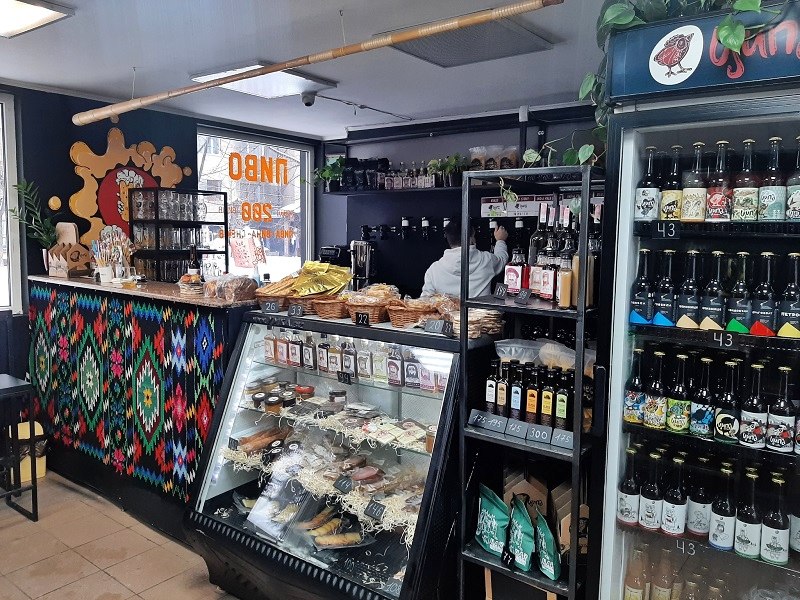
Rakhiv station
Rakhiv’s railway station is rather small, which isn’t all that surprising as you can count the daily train departures on one hand.
Although the station building has just a single ticket window, a public toilet and a couple of seats it was neatly appointed, clean and warm inside.
As I had already bought my ticket some weeks before through the easy-to-use online booking tool on the Ukrzaliznytsia website, I could walk straight to my train.








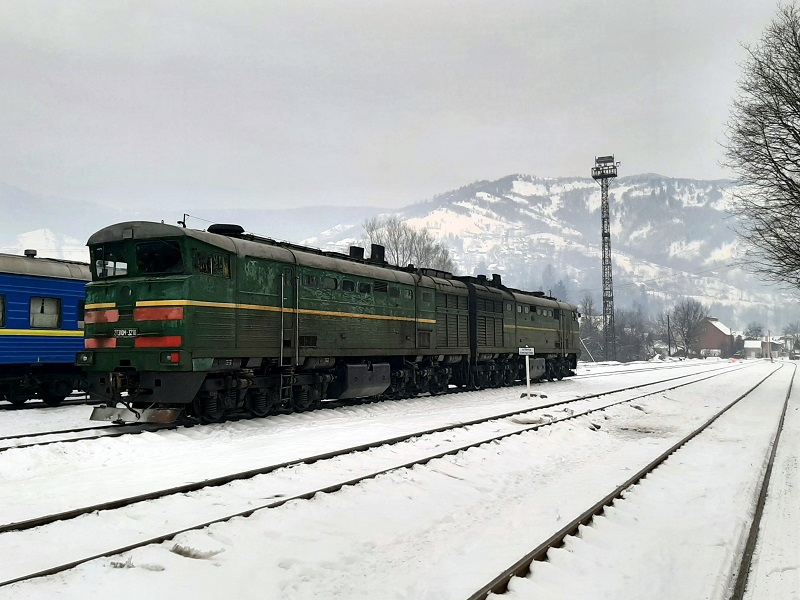
Ukrzaliznytsia Train Rakhiv to Mariupol
Train 006 ЛА – Departure: 12.40pm – Arrival: 5.26pm (+1 day)
Duration: 28h46m – Distance: 1,806 kilometres
First Class (Spalny Vagon), Wagon 5, Seat 1 – Costs: 180 EUR

Boarding the train
My train to Mariupol was already ready for boarding at platform 2.
I was booked in Spalny Vagon (often abbreviated as SV), which basically equals to first class on Ukrainian trains.
There are two berths in each Spalny Vagon compartment, while Kupe (2nd class) has four berths in each compartment.
If you are a solo traveller in Spalny Vagon you may have to share your compartment with one other passenger of the same sex, unless you book both berths and thus have the entire compartment for private use, which was exactly what I did.
With a Spalny Vagon ticket from Rakhiv to Mariupol costing 90 euro, I therefore paid 180 euro to have a private compartment on the train (a Kupe ticket would have cost €30 on this route in comparison).
Although this is quite expensive when you take into account Ukrainian price levels, I thought the privacy and comfort was well worth it on a journey this long.


Inside the compartment
The quality and comfort of my compartment was a pleasant surprise as the wagons on the Rakhiv-Mariupol train were either brand new or extensively renovated and modernised.
It certainly was not what I expected as the trains on all my previous travels across Ukraine featured decades-old sleeper wagons.
My Spalny Vagon compartment felt fresh, was spotlessly clean and had all kinds of smart little details which you won’t find on older trains.
Underneath the large table with cupholders were some power sockets, USB charging ports as well as a small shelf to put your mobile phone on.
Each bed also featured an individual reading light, as well as several hooks to hang up your jacket or clothes.
The train wagon was also fitted with climate control and you can fully adjust the airflow and temperature in your compartment.
The air-conditioning and heating system worked like a charm and my compartment was fortunately warm and cosy on this chilly winter day.
With the buttons on the electronic display, you can also adjust the brightness of the lights inside the compartment.
Most importantly, my train compartment turned out to be comfortable both in the daytime while seated as well as during the night when laying down and getting some sleep.
As you may expect when travelling in Spalny Vagon, the beds were already made up, with several pillows and some extra blankets being put on each bed.
There is plenty of space in the compartment to store your luggage, as you can put your bags in the empty space underneath the beds or in the large recess above the door.
As you can lock your compartment door from the inside, your personal belongings will be perfectly safe when you go to sleep, making train travel in Ukraine perfectly safe.


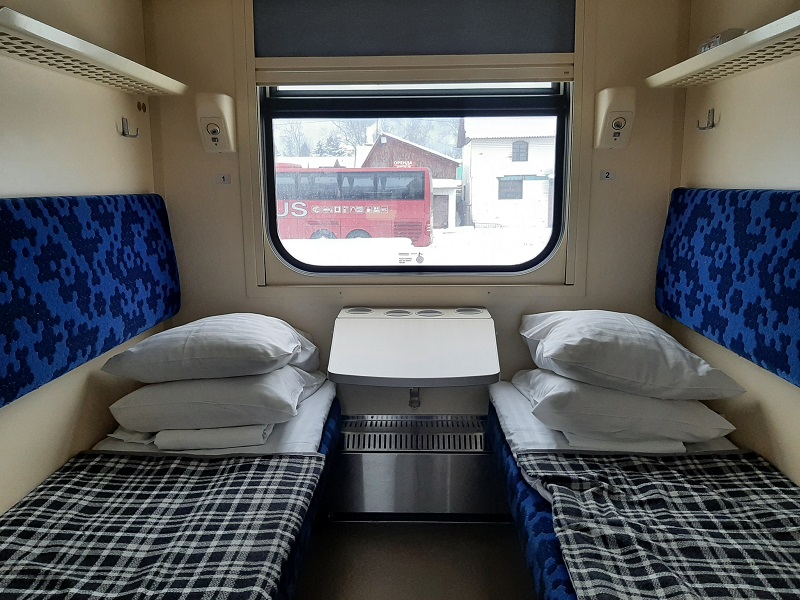




Toilets
Each wagon on the Rakhiv-Mariupol train has two shared toilets, one at each far side of the carriage.
Throughout the journey the toilets were kept perfectly clean.
A nice feature on this modern train is that you can see from the red and green lights on the electronic display in your compartment whether the toilets are occupied or available.


Amenity kit
A small amenity kit was provided as well on the train, although the contents weren’t much to write home about as it only consisted of a pack of tissues, wet wipes and toothpicks.
Besides this, a small bottle of water and a towel were provided as well.

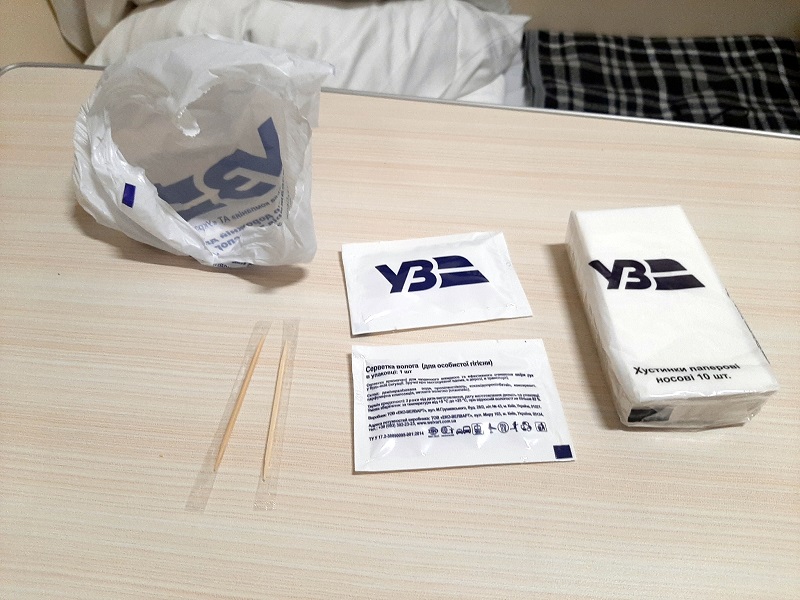
Departure
The night train to Mariupol left Rakhiv station on time and as you might expect the views are superb right from the start.
You don’t want to doze off during the first couple of hours of the ride as you will miss out on some excellent mountain scenery.
During the first part of the journey, the train follows the course of the River Tisza as it meanders through a beautiful mountain valley.



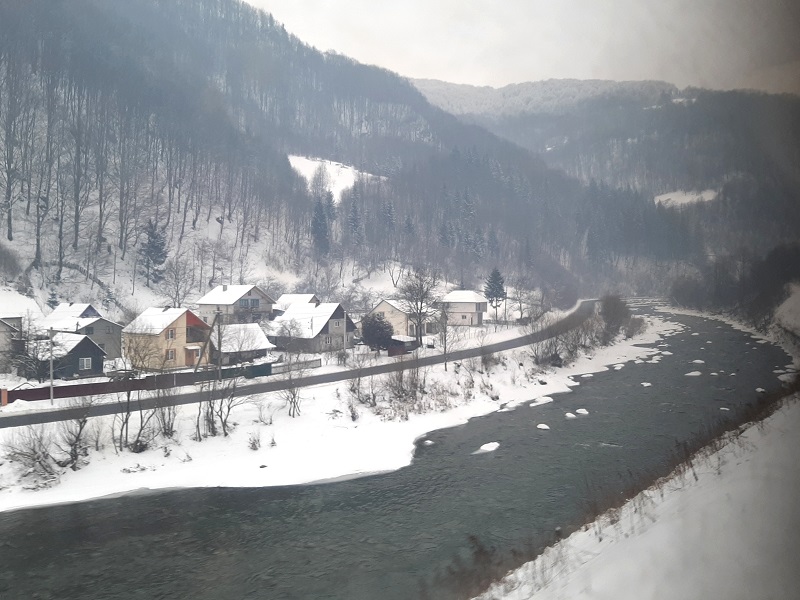
Winter landscapes
The journey through the Ukrainian Carpathians turned out to be as beautiful as the lovely train ride I took a day earlier through the Romanian part of this mountain chain.
Indeed, the train again passed along some forested hills and sleepy mountain villages, all blanketed with a fresh layer of snow.
It was certainly highly enjoyable to watch the scenery from the train and to spot the odd village church or rickety wooden suspension bridge across the Tisza.
After a short while, the Rakhiv-Mariupol train made its first scheduled stop at the station of Kvasy.
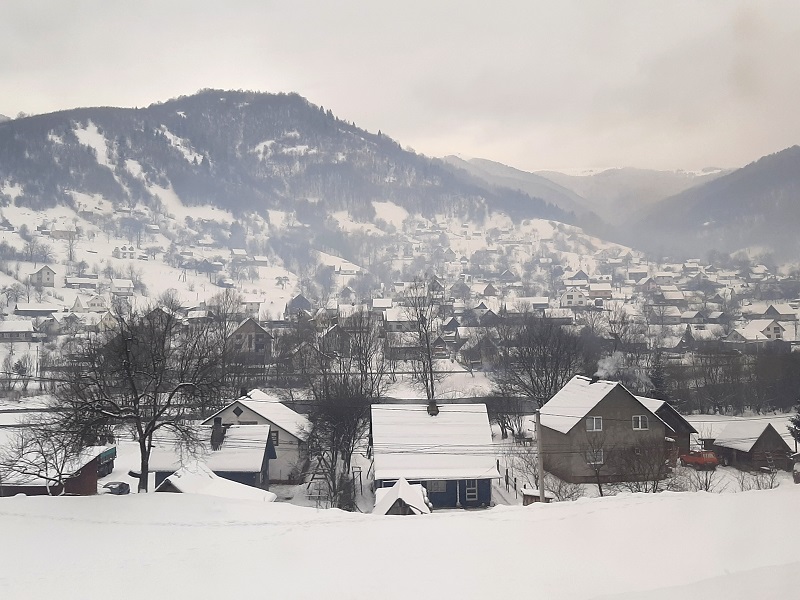





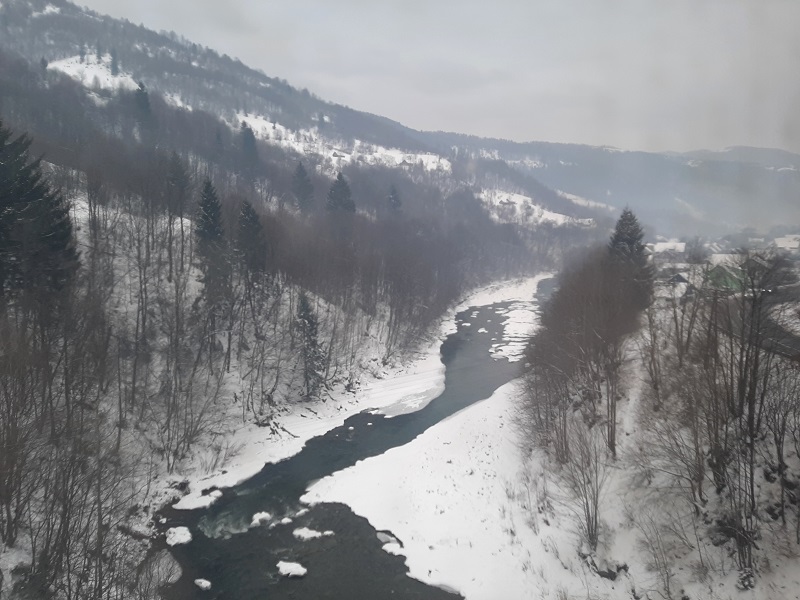
A cup of tea and a book
In my opinion, every long train journey you make requires a good book.
Given the ongoing tensions at the time of travel (late January 2022) with Russia amassing military hardware and troops at the Ukrainian border, I thought that Mark Galeotti’s “A Short History of Russia – From the Pagans to Putin” was an excellent book to read.
For about 50 eurocents, I ordered a cup of tea with the “provodnitsa” (female train attendant, provodnik being the masculine form).
Due to weird COVID rules the tea unfortunately came in a plastic cup instead of a proper tea glass in an elaborately designed nickel-plated “podstakannik” (tea cup holder, although the word literally means “thing under the glass”).
Of course, each Ukrainian long-distance train has a proper samovar in each wagon dispensing hot water for free.
If you want you can therefore also make your own cup of tea, coffee, hot chocolate or instant noodles if you bring your own supplies along.



Deer
One of the highlights of the journey happened around the halfway mark between the stations of Kvasy and Yasinya.
Between the railway line and the River Tisza, I spotted two deer running along the train!
The wildlife was the cherry on the top of what already was a gorgeous train ride, as the winter scenery got better by the minute as we slowly climbed up in the Carpathians.



Yasinya
After some 40 minutes on the train, the river valley widened quite a bit as we approached the town of Yasinya.
Although the previous stop at Kvasy seemed somewhat insignificant, there were quite a few people waiting on the platform of Yasinya station waiting to board the train.




Yasinya to Vorokhta
From Yasinya, it’s just over half an hour to Vorokhta, the next stop on our long trip to Mariupol.
Just before reaching Vorokhta, the train crosses the border between the oblasts (regions) of Zakarpattia and Ivano-Frankivsk.
Again, the scenery changed quite a bit along the way as the narrow river valley gave way to views of densely forested hills and mountains.
Just before reaching Voroktha station, the train basically circles the town over a railway viaduct, which makes for some fine views from the window.








Time for lunch
At this point of the journey, it was time to crack open my lunch supplies.
Unfortunately, there aren’t any dining cars on Ukrainian night trains, so you will have to bring your own supply of food and drinks on board.
When travelling in a shared compartment it’s even common for people to share some of their food.
Among others, I had brought along some meat balls, potato pancakes, a salad, salty string cheese, chocolate and two bottles of craft beer for lunch.
From Voroktha we slowly made our way towards the next station of Tatariv, a popular stop due to its proximity to the famous Ukrainian ski resort of Bukovel.
Indeed, one of the primary reasons behind the launch of the Rakhiv-Mariupol train was to offer a direct connection to the mountain resort towns of south-western Ukraine for those living in the east of the country.



Tatariv to Yaremche
From the station of Tatariv-Bukovel it was another short 30-minute hop to the following station of Yaremche, the last of the Carpathian resort towns where the Rakhiv-Mariupol train halts.
At this point, we already crossed the watershed and were on the northern side of the Carpathians, slowly making our way downhill again.
Between Tatariv and Yaremche the railway line follows the course of the River Prut, which later streams east towards Chernivtsi and the country of Moldova where it forms the border with Romania.










Yaremche to Ivano-Frankivsk
After Yaremche, the scenery quickly changes as the train leaves the Carpathian mountains behinds.
Already in the foothills the snow started to disappear and once we reached the plains around Ivano-Frankivsk there was hardly any snow left on the ground.
Instead, the views now consisted of endless fields in shades of brown and grey, which doesn’t make this part of Ukraine the most picturesque bit of the country to traverse in winter.
The train arrived on time in Ivano-Frankivsk, a major university city and commercial hub in south-western Ukraine.
At Ivano-Frankivsk, the Rakhiv-Mariupol train halted for 15 minutes, which made for a good opportunity to stretch my legs a bit on the platform.







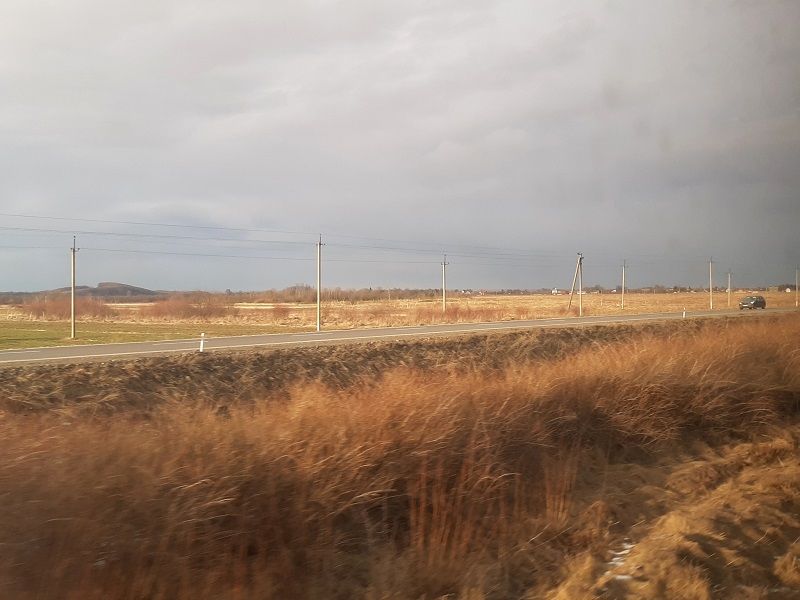







Ivano Frankivsk to Lviv
The stretch between Ivano-Frankivsk and Lviv is an ideal moment to read a book or doze off a bit as the scenery isn’t the most exciting.
Apart from the odd town and industrial complex, it’s again endless fields as far as the eye can see.
However, the sunset colours were absolutely amazing on this cold winter day and made for some beautiful views from the window.
At 6.33pm – a full ten minutes before the scheduled arrival time – the Rakhiv-Mariupol train pulled into Lviv’s gorgeous station.











Lviv station
The Rakhiv to Mariupol train makes a 37-minute stop at Lviv station, which in my case turned out to be a 47-minute stop due to the early arrival of our train.
As I was getting hungry again, I decided to make a run for a pizza restaurant recommended by a friend (Andy B. – who is well-worth a follow on Twitter if you like train travel).
Although the restaurant is located on the 2nd floor of a building directly opposite Lviv’s train station and adjacent tram stops, it was still a bit of a risk going there as I had no idea how long it would take them to make my pizza.
Fortunately, the chef at the Pizza Napoletana restaurant reassured me that it would be ready in time for me to get back to my train.
Indeed, the pizza was ready in about 15 minutes, which even left me with enough time to admire Lviv’s wonderful railway station before boarding my train again.
With its classic waiting halls with high ceilings and chandeliers as well as its beautiful train shed and old-fashioned wooden kiosks on the platforms, Lviv has always been one of my favourite railway stations in Europe.
It just oozes charm and history and still feels like a throwback to the architectural glory days of the early 1900s.
However, the presence of a couple of dozen Ukrainian soldiers on one of the platforms was a foreshadowing of darker times which soon would engulf Ukraine.









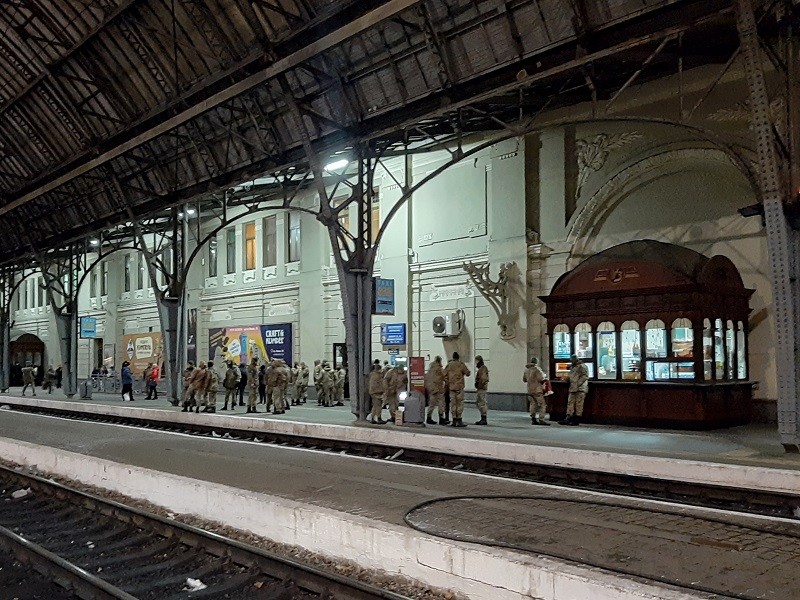
Back in the train
With a tasty pizza and a good bottle of Georgian wine, life inside my compartment was still cheerful however.
After a couple of hours eating, drinking and reading it was time to go to sleep as I wanted to wake up early the next morning.


Morning in Dnipro
After a good night of sleep I woke up some 30 minutes before the train arrived in the city of Dnipro in eastern Ukraine.
I wanted to wake up early enough to check the latest news updates about the build-up of Russian troops at the Ukrainian border.
As my destination of Mariupol was just miles away from the line of contact between the Ukrainian Army and the Russian Armed Forces in Russian-occupied Donbas, I wanted to be as much prepared as I possibly could be.
In case of worrying news happening overnight (field hospitals being set up, troops being moved to forward positions and other such signs of an imminent attack) I could still abandon my journey by leaving the train in Dnipro or Zaporizhzhia well before we would reach the Donbas.
There were however no major news updates or local gossips signalling such an imminent attack, so I knew that at least for the next few days the situation on the ground would remain safe and calm.
At Dnipro (a city of almost 1 million inhabitants formerly known as Dnipropetrovsk), the Rakhiv-Mariupol train makes a 15-minute stop, which was again a great opportunity to stretch my legs a bit.






Crossing the Dnieper
Another reason why I wanted to wake up early was because I didn’t want to miss the moment we would cross the River Dnieper.
The Dnieper river flows from the Valdai Hills near Smolensk, Russia all the way to the Black Sea and basically bisects Ukraine in half.
As the Dnieper is dammed at six different places across Ukraine, some large reservoirs were created along its course, making the river extremely wide and thus a formidable natural barrier.
Just a few minutes after departure from Dnipro, the train crossed the Amurskyi Bridge over the frozen water of the River Dnieper.





Onward to Zaporizhzhia
From Dnipro, it takes around one-and-a-half hour to reach Zaporizhzhia, another major city in eastern Ukraine.
Just like in Dnipro, there were many people leaving the Rakhiv-Mariupol train here with only few remaining on board for the final part of the journey into the Donbas.



Zaporizhzhia to Novobohdanivka
From Zaporizhzhia, the Rakhiv-Mariupol heads south on the railway line towards Melitopol.
This isn’t the classic route to Mariupol as the most direct railway line runs through the city of Donetsk.
However, since 2014 when Russian-backed separatists seized control of Donetsk and other parts of the Donbas, the Ukrainian Railways were no longer able to route their trains this way.
Instead, trains to Mariupol had to make a huge detour, first heading south from Zaporizhzhia to Novobohdanivka located about halfway on the line to Melitopol.
The ride south from Zaporizhzhia to Novobohdanivka was fairly pleasant as for a big part of the journey the railway line hugs the east bank of the Dnieper.
It was certainly special to see ice fishers walking on the frozen surface of the river.
A landmark to look out for on this railway line is the historic Popov Manor House (also called Popov’s Castle) in Vasylivka.
Built in Gothic Revival style and clearly visible from the adjacent railway tracks, this manor house was unfortunately completely ransacked by invading Russian troops in March.
At Novobohdanivka, the Rakhiv-Mariupol train makes a technical stop as the locomotive is attached to the other end of the train, allowing it to reverse direction and head out east on the railway line to Tokmak and Volnovakha.












Into the Donbas
After the technical stop at Novobohdanivka, we travelled eastward towards the border between Zaporizhzhia and Donetsk Oblast.
Before reaching Volnovakha in the Donbas, the train makes a single stop at the small settlement of Kamysh-Zorya while driving non-stop through larger cities like Tokmak.
The landscape looked a bit gloomy in this part of Ukraine as it was basically just dreary towns and villages and black soil fields as far as the eye could see.





Volnovakha
Volnovakha is a major railway hub in Donetsk Oblast and an important stop for the Rakhiv-Mariupol train.
At Volnovakha, the Rakhiv-Mariupol train stops for 20 minutes as it again reverses direction.
This time, the diesel engine which took us all the way here was decoupled from the train while an electric locomotive was attached at the other end (unlike the Novobohdanivka-Volnovakha line, the railway line from Volnovakha to Mariupol is electrified).
With its pastel-coloured station buildings, Volnovakha seemed like a nice little place.
Unfortunately, the city of Volnovakha would soon suffer the same fate as Mariupol it being all but completely levelled by the invading Russians.






The last stretch to Mariupol
Darkness fell fast after departure from Volnovakha.
Apart from the smoke coming from the chimneys of the massive steel factories on the outskirts of Mariupol, the views were fairly limited.
After a nearly 29-hour-long journey, the Rakhiv-Mariupol train finally arrived at its destination being bang on schedule.
It felt a bit surreal disembarking the train and walking on the platforms of Mariupol’s railway station having crossed the entire of Ukraine from west to east in these challenging times.
However, everything still seemed peaceful as I watched passengers being welcomed by their friends and family and escorted into cars, taxis and buses waiting outside the station.

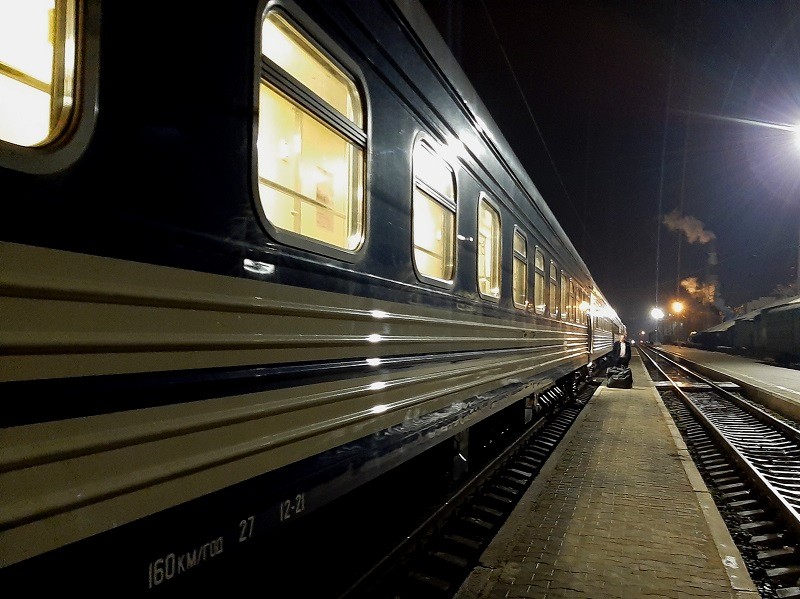





Conclusion
Rakhiv to Mariupol used to be Ukraine’s longest passenger train route and it certainly was a journey I have fond memories of.
It’s a gorgeous journey on a modern and comfortable train which takes you from the Carpathian Mountains in south-western Ukraine all the way to the Donbas in the far eastern reaches of the country.
On the way you see deer running along the railway line, skiers and snowboarders boarding the train in different Carpathian mountain resorts and beautiful stations in historic cities like Ivano-Frankivsk and Lviv.
The following day you wake up in eastern Ukraine as the train halts in important places like Dnipro and Zaporizhzhia and crosses the mighty Dnieper River.
In 29 hours you really get to see how geographically diverse Ukraine is.
However, writing this review of the Rakhiv-Mariupol train also brings back feelings of sorrow, knowing that it’s no longer possible to make the same journey and that it’s still unclear whether it will ever be in the future.
Cities on the train line such as Mariupol and Volnovakha have been almost completely destroyed by Russia, which still occupies vast swaths of Ukraine.
Nowadays, the lovely, hard-working staff at Ukrzaliznytsia still operates trains to the frontlines in eastern Ukraine under immensely difficult circumstances.
This article is a testimony to their important work, which will hopefully be rewarded one day with Ukrzaliznytsia being able to operate passenger trains again to cities all across a fully liberated and free Ukraine from Mariupol to Kharkiv and from the Donbas to Crimea.
Trip report index
This article is part of the ‘Mail From Mariupol: A Pre-War Trip to Ukraine by Train‘ trip report, which consists of the following chapters:
1. Review: Night Train Bucharest to Sighetu Marmatiei, Romania
2. At the Sighet-Solotvyno Border: From Romania Into Ukraine
3. Review: Solotvyno to Rakhiv by Bus
4. Review: Hotel Europa, Rakhiv, Ukraine
5. In the Land of the Hutsuls: A Visit to the Town of Rakhiv
6. Rakhiv to Mariupol: Riding Ukraine’s Longest Train Route (current chapter)
7. A Tribute to Mariupol: Memories of a Pre-War Visit
8. Ukrainian Railways Mariupol to Kiev Train in Platzkart
9. Review: Ibis Kyiv Railway Station Hotel
10. Review: Kyiv-Pasazhyrskyi Station First Class Lounge
11. Ukraine Night Train: Over the Mountains to Mukachevo
12. Review: Latorca InterCity Train Mukachevo to Budapest
13. A Short Stopover in Szolnok, Hungary
14. Review: Ister Night Train Budapest to Bucharest
15. Epilogue: Witnessing the Ukrainian Refugee Crisis at the Border


As good as ever Koen! Let’s hope it’s possible to make this journey again before too long.